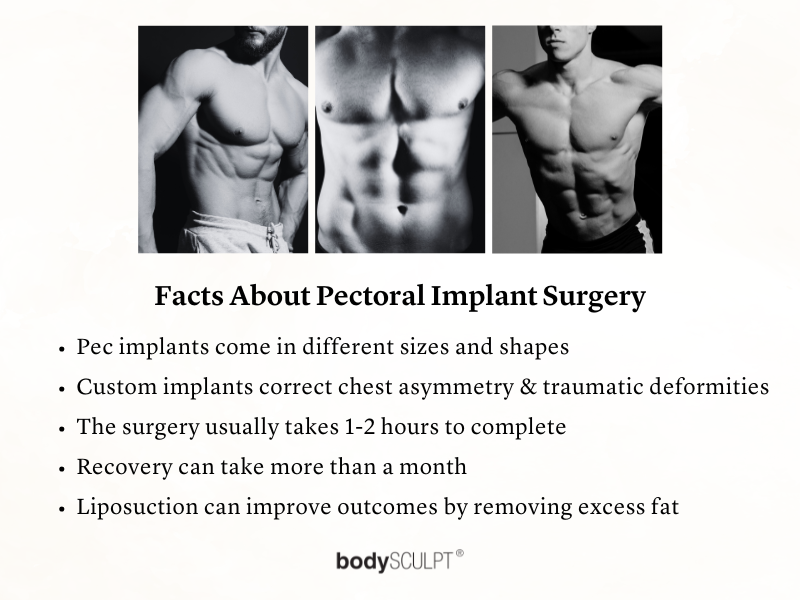Men who want a perfectly shaped chest spend hours in the gym to achieve this goal. However, most often, even these measures cannot provide the sculpted, muscular look they want. This is why more and more men are seeking pectoral implant surgery. Established AAAASF-accredited plastic surgery practices offer male pectoral implants in NYC to help men who badly want a more sculpted masculine chest that they could not achieve with exercise and diets.
Table of Contents

How Pectoral Implant Surgery is Performed
Pectoral implant surgery involves placing solid silicone implants under the pectoral muscles to enhance the appearance of the chest. The surgeon makes a small incision in the armpit, about 2 inches long, to create a pocket under the pectoralis major muscle. The implant is then placed beneath the muscle to create a bigger, broader chest by bringing the pectoralis major muscle forward and increasing the projection and mass of the pectorals. The procedure is usually performed on an outpatient basis using general anesthesia. Successful pectoral implant treatment provides more muscularity and better chest definition.

5 Facts to Know About Pectoral Implants Surgery
Here are some important things to know about male pec implants:
- Pec Implants come in Different Sizes and shapes: Like breast implants for females, implants for men also come in different sizes and shapes. Before undergoing surgery, you should discuss your goals with your surgeon to ensure that you get the right implants. An expert can help you determine the correct size to achieve a natural-looking, sculpted chest.
- Candidates are not just those who want a Masculine Chest: Pec implants are an ideal option for men who can’t build their chest with even rigorous workouts. Men who have Poland syndrome (birth defect characterized by underdeveloped chest muscle can also benefit from pec implant surgery. It is also beneficial for people who need chest reconstruction after cancer surgery. Silicone implants are a safe option for these patients to create bulk in the chest area.
- The Procedure usually takes 1-2 hours to Complete: Pectoral implant surgery is performed under general anesthesia. The procedure will only take between 1-2 hours to complete and is done as an outpatient procedure. You can return home the same day. The procedure involves inserting the implants under the chest. For that, an incision of about 2 inches in length is made in the armpit. A pocket is then created to insert the implant under the pectoralis major muscle. The incisions are closed with sutures that will dissolve over time. When your incisions heal, your scars will not be visible. Following your surgeon’s instructions will help recovery so you can return to your normal activities as soon as possible.
- Recovery can take more than a Month: Sometimes, recovery can extend up to a month or more. If you recover smoothly, you can resume your routine activities in 4 weeks. You may experience some mild to moderate discomfort for the first few days and taking the pain medications prescribed by the surgeon will help with that. It is important to contact your surgeon if the pain is unbearable or you experience fever or swelling. If your surgeon recommends wearing a compression garment, do so. If your job involves strenuous activities, ask your surgeon for advice. Avoid the activities that your doctor hasn’t allowed you to do.
- Liposuction is possible along with Pectoral Implants: If you want a more dramatic enhancement, your surgeon can perform pectoral etching. This is a combination of liposuction and pectoral implants. To perform pectoral etching, your surgeon will use a liposuction tool to eliminate extra fat pockets surrounding the chest area. This is done before the chest implants are placed, so that your chest looks more defined.
Tips to Recover
- Maintain Hydration: Make sure to drink adequate water. Drinking plenty of water will promote healthy circulation and the healing of wounds, so keep a water bottle with you at all times.
- Eat a Healthful Diet: Following surgery, a healthy diet will provide your body with the nourishment and energy it needs to repair your incisions. To make sure you are sticking to a nutritious diet during your recuperation, you might want to talk to a dietician about a meal plan.
- Wear the Recommended Compression Garment: Throughout your six-week recuperation period, you will need to wear a compression garment to reduce edema around the treatment areas. Its pressure on the locations of your incisions will help minimize swelling.
Patients are instructed not to lift their arms for the first two days following the surgery. Your chest muscles may feel constricted just after surgery, along with stiffness and pain. You might feel some chest pain when the anesthesia wears off, but it’s crucial to get in touch with your surgeon if the pain is severe or lasts for a long time. After the operation, redness and swelling are typical but should resolve quickly. A month is usually enough time for the residual edema to go down, facilitating a quicker recovery.
Pectoral implants in NYC can be tailored to a patient’s individual needs and goals. Choosing a surgeon who has extensive experience in performing male pectoral implant surgery can minimize risk of complications and help you achieve your specific aesthetic goals.
Get a sculpted and masculine chest with pectoral implants in NYC!
